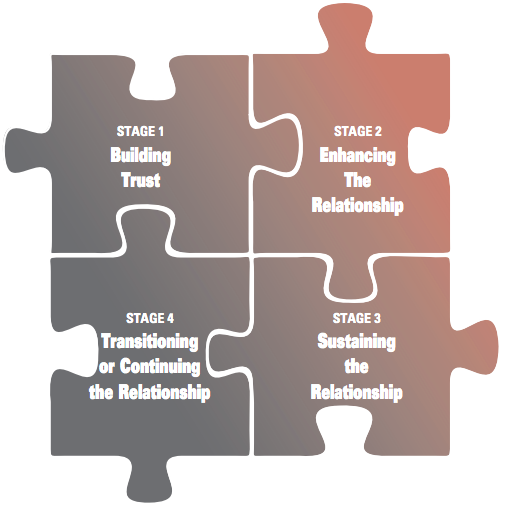Stages of Mentoring Relationships
Many mentoring relationships follow these four stages - though they frequently overlap, and often go back and forth. This is normal. Remembering these stages may help you build and sustain your mentoring relationship.
Stage 1: Building trust
- Both the mentor and mentee are trying to define their roles in the relationship.
- In this phase, the mentor will need to take more of the initiative to build the friendship, as the mentee may just be beginning to understand how to develop a friendship with an older adult they don’t know yet.
- Youth will sometimes test the limits of the friendship at this time. This is a time to set clear boundaries with your mentee, creating a foundation for mutual trust and respect.
- Remember, you were matched with your mentee based on similar interests. Focus on these common interests, and fun together.
- A mentor’s role is often very different from other adult/youth relationships you may have been involved in before. Remembering your role, and using the program as a resource for understanding this unique relationship,is a great way to get the most out of your mentoring relationship.
- As your trust and comfort with each other grows, conversations and what you do together becomes more of a mutual decision.
- Enhance your mentee’s life skills by helping them see themselves as capable thinkers and decision makers in their life. (remember the article, “Honoring the mentee’s Rights to Self-Determination.”)
- Expand your mentee’s world view by exploring new ideas, new people and new places. Many youth can often only see the possibilities that they have seen for themselves so far, a mentor offers a new window into other options for a mentee as they think about their own possibilities and potentials. (Mentors often get the added benefit of their own world view being expanded as well)
- Trust has been established, and conversations can often become more comfortable, personal and open.
- Both the mentor and mentee are actively contributing to the relationship.
- Mentees feel more comfortable, and may begin seeing mentors as a problem solver. Continue to help your mentee to assess the problem, identify solutions, and review pros and cons of different choices.
- Remembering your role as a friend, guide and advocate will help your mentee develop important life long skills to become better problem solvers and critical thinkers.
- There are times when looking back (and forward) in a relationship is a healthy and wonderful thing to do.
- When an opportunity presents itself, reflecting together on your relationship (what is going well, what could make our friendship better…?) allows for healthy closure when the time comes.
- Closure is a natural part of the mentoring cycle, and should be acknowledged as a natural part of life. We know support during closure is critical in ensuring positive outcomes for both the youth and the mentor volunteer.
- Healthy closure gives mentees an opportunity to reflect on their experiences and practice positive communication with a trusted adult.
- Formal and guided closure is an opportunity to:
- Model to youth that relationships and people change over time, and being open to this change is part of being in a healthy relationship.
- Reflect back on the mentoring friendship - think about memories and what each learned from the other.
- Set realistic plans for continued communication.
- Say thank you for being open to a mentoring relationship.
- Let the program director know when you and your mentee are ready to have formal closure, so they can support you in this delicate process.





